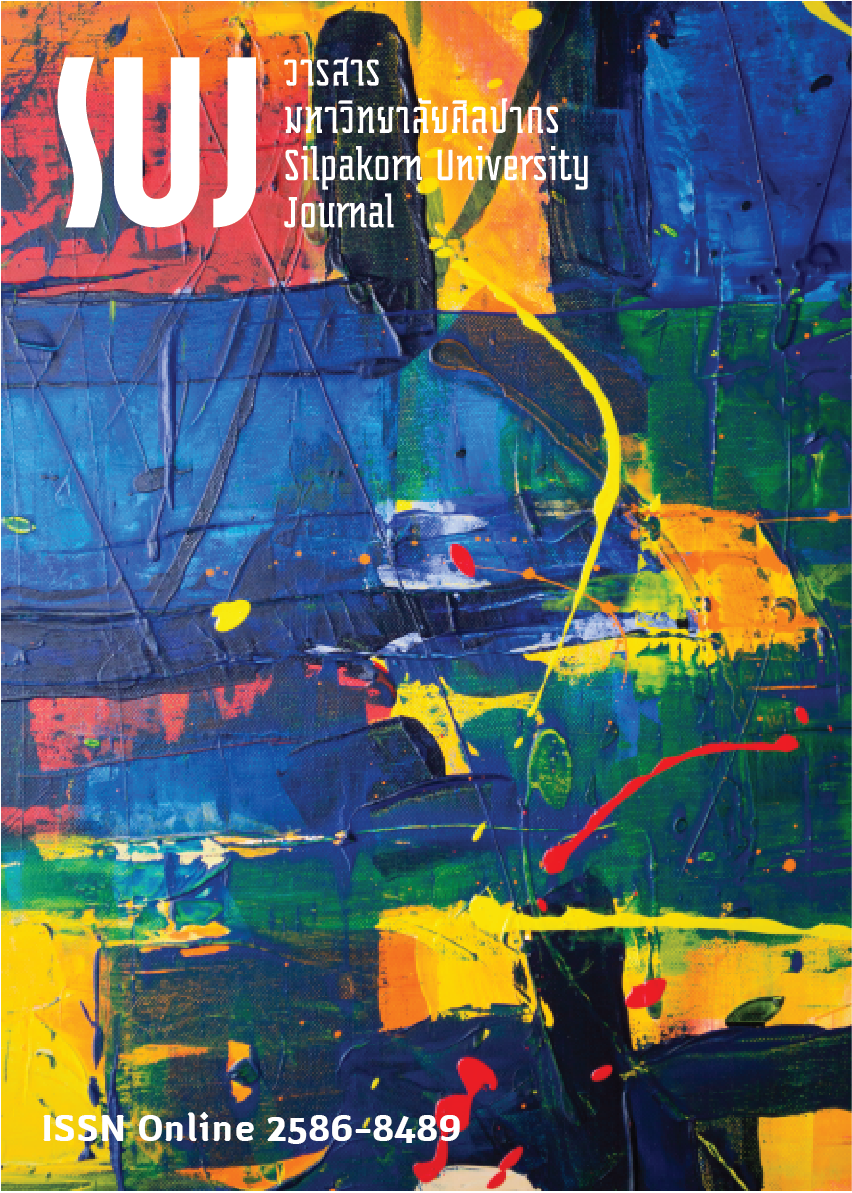ความต้องการเทคโนโลยีดิจิทัลและสารสนเทศเพื่อการสื่อสารในกลุ่มผู้สูงอายุ (The demand for information technology and digital communications among the elderly)
Main Article Content
Abstract
การวิจัยครั้งนี้มีวัตถุประสงค์เพื่อสำรวจการใช้เทคโนโลยีสารสนเทศและความต้องการในการฝึกอบรมด้านเทคโนโลยีในกลุ่มผู้สูงอายุ กลุ่มตัวอย่างในการวิจัยใช้วิธีสุ่มจากพื้นที่ 5 ภูมิภาค จำนวน 13 จังหวัด ขนาดตัวอย่างของกลุ่มผู้สูงอายุอยู่ที่ 2,208 ตัวอย่าง เครื่องมือที่ใช้ในการวิจัย คือ แบบสัมภาษณ์ ผลการวิจัยพบว่ากลุ่มผู้สูงอายุตอนต้นและตอนกลางส่วนใหญ่อยู่ในกลุ่ม “ติดสังคม” หรือกลุ่มที่สามารถช่วยเหลือตนเองได้ดี ร้อยละ 99.5 และ 98.9 ตามลำดับ สำหรับผู้สูงอายุตอนปลายส่วนใหญ่จะได้รับการประเมินให้อยู่ในกลุ่ม “ติดสังคม” เช่นเดียวกับสองกลุ่มแรก แต่สังเกตได้ว่าสัดส่วนของผู้ที่ถูกประเมินให้อยู่ในกลุ่ม “ติดเตียง” มีมากขึ้นอย่างเห็นได้ชัด ร้อยละ 5.0 ด้านการใช้อุปกรณ์อิเล็กทรอนิกส์ กลุ่มผู้สูงอายุตอนต้นส่วนใหญ่มีการใช้โทรศัพท์มือถือแบบสมาร์ทโฟนในสัดส่วนที่มากกว่าโทรศัพท์มือถือแบบฟีเจอร์โฟน ซึ่งส่งผลดีต่อผู้สูงอายุในแง่ของการใช้งาน ส่วนกลุ่มผู้สูงอายุตอนกลางและตอนปลายส่วนใหญ่มีการใช้โทรศัพท์มือถือแบบฟีเจอร์โฟนในสัดส่วนที่มากกว่าโทรศัพท์มือถือแบบสมาร์ทโฟน ซึ่งอาจส่งผลให้ผู้สูงอายุมีข้อจำกัดในการใช้งาน เมื่อพิจารณาความต้องการในการฝึกอบรมด้านเทคโนโลยีสารสนเทศ พบว่า กลุ่มผู้สูงอายุตอนปลายไม่มีความสนใจในหลักสูตรใด แต่ผู้สูงอายุตอนต้นและตอนกลางสนใจการค้าขายออนไลน์และการตลาดผ่านโซเชียลมีเดีย รวมถึงการใช้ ICT พื้นฐานและเนื้อหาเกี่ยวกับความเข้าใจดิจิทัล ซึ่งชี้ให้เห็นว่าผู้สูงอายุทั้งสองกลุ่มนี้ยังต้องการนำเทคโนโลยีเข้ามาใช้ในชีวิตประจำวัน
This research aims to survey information on the elderly’s requirements of technology usage and technology training. A sample in this research was chosen randomly from 13 provinces in 5 regions, totaling 2,208 individuals. A tool used in the research was an interview. The research findings found that most of the early- and mid-elderly groups belong to the "social-bound" group that are able to help themselves well, with 99.5% and 98.9%, respectively. Most of the late seniors were evaluated as a "social-bound" group similar to the first two groups. However, the proportion of those categorized as the "social-bound" group has increased significantly by 5%. Electronic devices the majority of early seniors’ use are mobile phones such as smart phones which is in a greater proportion than feature phones indicating a positive effect on the elderly in terms of usability. While most of the mid- and late-elderly groups use feature phones which is in a greater proportion than smart phones resulting in the limitation of usage. Considering the need for information technology training, it was found that the late-elderly group does not have any interest in the curriculum. However, the early- and mid-elderly are interested in online commerce and social media marketing, including the use of basic ICT and digital understanding content showing that the two groups also want to use technology on a daily basis.
Downloads
Article Details

This work is licensed under a Creative Commons Attribution-NonCommercial-NoDerivatives 4.0 International License.
References
Chuchuang, Israporn. (2012). The study of best practice to participate in social development activities of the senior citizens club, Muang district, Nakhon Pathom province (การศึกษาวิธีปฏิบัติที่เป็นเลิศในการเข้าร่วมกิจกรรมการพัฒนาสังคมของชมรมผู้สูงอายุ อำเภอเมือง จังหวัดนครปฐม). Veridian E-Journal, Silpakorn University, 5(2): 499-512.
Foundation of Thai Gerontology Research and Development institute. (2016). Situation of the Thai Elderly 2015 (สถานการณ์ผู้สูงอายุไทย พ.ศ. 2558). Bangkok: Amarin Printing and Publishing Public.
Foundation of Thai Gerontology Research and Development institute. (2016a). Situation of the Thai Elderly 2016 (สถานการณ์ผู้สูงอายุไทย พ.ศ. 2559). Nakhon Pathom: Institute for Population and Social Research, Mahidol University.
Foundation of Thai Gerontology Research and Development institute. (2018). Situation of the Thai Elderly 2018 (รายงานสถานการณ์ผู้สูงอายุไทย พ.ศ. 2561). Nakhon Pathom: Institute for Population and Social Research, Mahidol University.
Kchanan, Ratima. (2018). Aging Society and Driving the Thai Economy (สังคมผู้สูงอายุกับการขับเคลื่อนเศรษฐกิจไทย). [Online]. Retrieved March 29, 2020 from https://library2.parliament.go.th/ejournal/content_af/2561/jul2561-1.pdf
Loipha, Samarn. (2014). The Internet Use Behavior of Adults in The Rural Area (พฤติกรรมการใช้อินเทอร์เน็ตของผู้ใหญ่ในเขตชนบท). Information, 21(2): 18-28.
National Statistical Office. (2014). Report on the 2014 Survey of the Older Persons in Thailand (การสำรวจประชากรสูงอายุในประเทศไทย พ.ศ. 2557). [Online]. Retrieved March 29, 2020 from http://www.nso.go.th/sites/2014en/Pages/survey/Social/Demographic,%20Population%20and%20Housing/The-Survey-Of-Elderly-In-Thailand.aspx
National Statistical Office. (2015). Factors Affecting Internet Usage for the Elderly in Thailand 2014 (ปัจจัยที่มีผลต่อการใช้อินเตอร์เน็ตสำหรับผู้สูงอายุในประเทศไทย พ.ศ. 2557). [Online]. Retrieved March 29, 2020 from http://www.nso.go.th/sites/2014/DocLib13/%E0%B8%94%E0%B9%89%E0%B8%B2%E0%B8%99ICT
Office of the National Economic and Social Development Council. (2018). National Economic and Social Development Plan (แผนพัฒนาเศรษฐกิจและสังคมแห่งชาติ ฉบับที่ 12 พ.ศ. 2560 - 2564). Bangkok: Office of the National Economic and Social Development Board.
Saraphon, Thidarat. (2018). Information Need to Improve Quality of life for the Elderly of Elderly School in Ma-Aue Sub-District, Thawatburi District, Roi-Et Province (ความต้องการสารสนเทศของผู้สูงอายุเพื่อพัฒนาคุณภาพชีวิตของผู้สูงอายุ โรงเรียนผู้สูงอายุ ตำบลมะอึ อำเภอธวัชบุรี จังหวัดร้อยเอ็ด). NRRU Community Research Journal, 12(3): 114.
Savangkit, Weenarut. (2019). Development of Elderly People’s Information Technology Competency in Chiang Rai Province by Competency-Based Training (การพัฒนาสมรรถนะการใช้เทคโนโลยีสารสนเทศสำหรับผู้สูงอายุในจังหวัดเชียงราย โดยใช้รูปแบบการฝึกอบรมฐานสมรรถนะ). Journal of Chandrakasemsarn, 25(2): 81.
Thammasat University Research And Consultancy Institute. (2018). Thailand Digital Inclusion Research Activity (กิจกรรมการศึกษาวิจัย Thailand Digital Inclusion). Digital economic and social development plan project.
United Nation. (2015). World Populations Ageing 2015. New York: United Nation.


